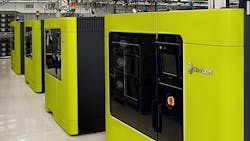By now, we’ve all heard numerous explanations about how 3D printing and/or additive manufacturing (AM) will change the business of manufacturing (in case you haven't, here’s a link to one of my earlier posts that hits many of the main points). Aside from a number of anecdotal success stories, however, the barriers to large-scale industrial applications of 3D printing/AM appear to make 3D printing/AM more of a future likelihood than a near-term reality.
The announcement of CloudDDM could change that—and the company is hinging its potential for success on two critical factors: automation and location.
CloudDDM (DDM stands for direct digital manufacturing) launched its additive manufacturing operations on May 5, 2015, on the UPS Supply Chain Solutions Campus at UPS Worldport in Louisville, Ky., a site often referred to as the world’s largest automated packaging handing facility. This strategic location of the company’s production operations is estimated to give CloudDDM as much as a six hour jump on its 3D printing competitors, giving users more time to submit orders and CloudDDM more time to fulfill those orders, according to Anthony Graves, co-founder of CloudDDM.
Graves notes that an equally important aspect of CloudDDM’s advantage in the marketplace is the company’s completely automated order processing and production processes. “Our automated additive manufacturing system allows us to accept orders, spawn print jobs, and produce parts with zero human intervention,” Graves says. “Users upload files for parts to our CloudDDM app where they can create print jobs by selecting material, part color, part finishing, and lead time options.”
The file format currently supported by CloudDDM is an STL (stereolithography) file, one of the most widely used rapid prototyping and 3D printing file formats. According to Graves, CloudDDM plans to add support for STEP and Parasolid file formats in the near future.
Though the company officially launched on May 5, it has been operating in beta mode to produce parts for nearly every type of industry, ranging from aerospace and automotive to medical and packaging OEMs.
When a user begins to configure a print job using the CloudDDM app, Graves says CloudDDM’s production scheduling and control system checks system capacity and presents the user with pricing and available options for production priority (lead time) delivery. “For example, if a user would like to print twenty-five parts, our system will check production time and report back based on their material, color selection, and production priorities. Our system may return one, two, or five business days as available delivery options. Another user may need a larger quantity, say 50 parts, so the system will calculate production times and capacity and offer this user two or five business days,” Graves says.
Asked to further explain this automated process in terms of system connections and hardware and software used, Graves says, “While the technology is pretty straightforward, the individual components and how we have configured our system is treated as a trade secret.” However, he does point out that the hardware and software aspects of the CloudDDM system were “designed from the ground up specifically for production and scale. Because our system was designed for our own use, and not for resale, we were able to focus all of our efforts on the streamlining the process; something we believe gives us a strong competitive advantage.”
In terms of the type of additive manufacturing performed by CloudDDM, Graves says the company is “exclusively focused on industrial AM grade parts using fused-deposition-modeling, or FDM. We currently offer four industrial thermoplastics: ABS, polycarbonate, polycarbonate-ABS, and ULTEM 1010.”
Reference charts comparing these materials and their mechanical, thermal and electrical capabilities are accessible from the Resources page on the CloudDDM site.
“A bigger distinction,” Graves notes, “is that our system is focused on industrial applications at large scale or volume—for either many small customers, or many large customers—with the ability to handle production quantities from 5 to 5,000.”
The CloudDDM production operation “is designed so that it can be managed by just one person per shift,” Graves says. In addition to basic tasks, such as managing materials supplies for the machines, production staff will inspect finished parts and supervise packaging. He clarifies that, with the amount of volume the company is already looking at producing, CloudDDM will eventually need more than one person per shift, but not the amount of people normally required to support a traditional production operation of this size. People will be needed, Graves adds, because “things will happen—a part will fall off a conveyor, things will get stuck.”
Asked to explain how CloudDDM compares to AM competitors such as Shapeways and Materialise, Graves says, “There are other AM companies out there, but the problem is competition for capacity at these facilities. 3D printing, like traditional manufacturing processes, can only be done so fast. And when you can’t find the capacity to do a whole job with one supplier within the required lead time, you have to split it up among multiple suppliers, which can lead to high degrees of variability in fit, finish, and quality using AM technology from different suppliers. This is unlike traditional CNC manufacturing where anyone can machine, say, 500 aluminum parts using a wide range of machines and the parts will be nearly identical.”
Graves maintains that the software and hardware automation connecting all aspects of CloudDDM’s processes, from order entry through production—as well as the time savings gained from its key location—will allow the company to address AM’s inherent scalability issues and avoid the capacity issues faced by other AM suppliers.
Leaders relevant to this article:


